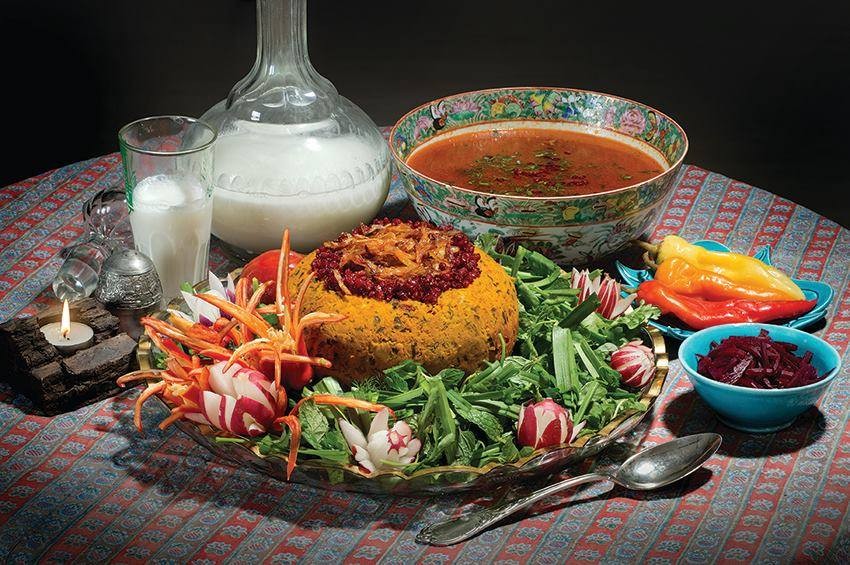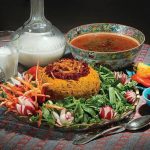Persian Cuisines
- Culinary
- No Comments
- 3 Min Read


By Atefeh Dehghan
Iranians are very serious about what they eat, and this may be one reason why Iranian cuisine is very healthy and nutritious. Iranian meals include breakfast, lunch, and dinner, and a lot of tea between regular mealtimes. Breakfast usually consists of bread, local sheep’s or feta-like cheese, and tea. A more substantial version consists of boiled, fried, or scrambled eggs; grilled sausages in tomato sauce; and honey or jam. Lunch is usually eaten between 1:00 to 3:00 PM. Restaurants serve lunch from about 11:30 AM to 3:00 PM, and it is almost impossible to find one willing to serve a meal after this. Lunch consists of the inevitable rice served in vast helpings with kebabs or khoreshts. Salads and yogurt are also musts and are delicious aids to digestion. Almost the same choice comes for dinner, though nowadays many prefer fast food. Iranians like to eat without hurry, that is why, perhaps, late dinner remains the main meal of the day. At a private party, do not expect a meal before 10:00 or 11:00 PM. Eating out is popular, and, as a rule, restaurants work from 6:30 PM until 12:00 PM and may have problems with the authorities if they stay open later, even if they only wait for the last client to leave.
Iranian Cuisine
With its excellent local produce, allowing the widest choice of fresh vegetables and fruit during the four seasons, Iranian cuisine is made up of a great variety of dishes. The most popular of them (and those that are likely to be found on the restaurants’ menus) are presented:
Polo
Polo, often called pilaf in the West, is the name applied to rice with which other ingredients are mixed in the cooking process.
Kebab
Kebab is skewered meat or chicken grilled over charcoal. It has three main varieties (from top to bottom): kubideh (ground meat), jujeh-kebab (chicken), and barg (chopped mutton). All three are often served with barbequed tomatos.
Khoresht
Khoresht is a sort of stew with meat, vegetables, and other ingredients. Both kebab and khoresht are served with chelo, plain rice.
Rice, meat (mainly mutton), and vegetables are the main ingredients of Iranian cookery. They come in a countless number of combinations, all delicious. Iranian long-grain rice is among the world’s best. However, because it is quite expensive, it is seldom served in restaurants. Iranians serve rice as chelo or polo. Chelo is white rice, boiled and steamed, often decorated with yellow rice, dyed and flavored with saffron. If the rice is cooked in the way common in the West, it is called kateh. Often the cooks steam a layer of chela, mixed with yogurt and an egg yolk on the pan’s bottom to make a crunchy golden crust called tahdig. This is served in addition to the plain rice.
Places to Eat
Finding a place to eat is seldom a problem. Very few restaurants risk their reputation by serving inferior food, and the prices are more than affordable. Special requirements, however, are seldom met, and true vegetarians do not fare well in Iran. Nonetheless, the restaurant staff are generally helpful, and with some ingenuity and good will a solution is often found. No restaurant is equipped for wheelchairs but most can be easily accessed. Many restaurants have, for women and families, a special area from which solitary men are barred – the waiter will usher you to the right place. The restaurants in the list below have been selected for the excellence of their food. Many hotels also have good restaurants, although their prices often reflect the atmosphere rather than the quality. In smaller towns, however, there are few eating places, so the hotel restaurants are often your best bet.
Other traditional dishes
Abgusht is the most traditional Iranian dish. It contains meat, potatoes, peas, beans, onions, and dried limes, and is spiced with turmeric. Abgusht is both the first and the main course. Eating abgusht requires some skill. First, its liquid is poured into a bowl and eaten with bread. Then the meat and vegetables are mashed and eaten with fresh herbs and pickles.
Bread
Four main kinds of bread are baked throughout Iran: sangak (made in thick flaps and baked on hot stones), barbari (thick, oval bread), taftun (round thin bread with small holes pierced it it with a knife), and lavash (thin bread baked on the sides of the heated oven). Every kind Sangak bread is best when at least 60 c fresh and crisp. In many places, an assortment of local bread is also baked.
Drinks
Tea is always served at home and in the workplace. Fruit juices and carbonated beverages are also popular. The sale and consumption of alcoholic beverages have been prohibited since 1979.
Fruits
The Iranian climate allows a great variety of fruit in every season. Fruit is served after tea to guests at home and offices. The plate of seasonal fruits often includes small cucumbers.


